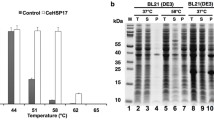Abstract
This is a short paper on new ways to think about the structure and function of small heat shock proteins (sHSPs), perhaps the most enigmatic family among protein chaperones. The goal is to incorporate new observations regarding the disordered regions of small heat shock proteins (sHSPs) into the large body of structural information on the conserved structural alpha-crystallin domains (ACD) that define the sHSP family. Disordered regions (N-terminal region and C-terminal region or NTR and CTR, respectively) represent over 50% of the sHSP sequence space in the human genome and are refractory to traditional structural biology approaches, posing a roadblock on the path towards a mechanistic understanding of how sHSPs function. A model in which an ACD dimer serves as a template that presents three grooves into which other proteins or other segments of sHSPs can bind is presented. Short segments within the disordered regions are observed to bind into the ACD grooves. There are more binding segments than there are grooves, and each binding event is weak and transient, creating a dynamic equilibrium of tethered and untethered disordered regions. The ability of an NTR to be in dynamic equilibrium between tethered/sequestered and untethered states suggests several mechanistic alternatives that need not be mutually exclusive. New ways of thinking about (and approaching) the intrinsic properties of sHSPs may finally allow the veil of enigma to be removed from sHSPs.



Similar content being viewed by others
References
Baughman HER (2019) Chaperone effects on tau amyloid formation. Ph D Thesis Univ of Washington
Baughman HER, Pham T-HT, Adams CS, Nath A, Klevit RE (2020) Release of a disordered domain enhances HspB1 chaperone activity toward tau. Proc Natl Acad Sci U S A 117(6):2923–2929
Cherian-Shaw M, Smith JB, Jiang XY, Abraham EC (1999) Intrapolypeptide disulfides in human alphaA-crystallin and their effect on chaperone-like function. Mol Cell Biochem 199(1–2):163–167
Clouser AF, Baughman HER, Basanta B, Guttman M, Nath A, Klevit RE (2019) Interplay of disordered and ordered regions of a human small heat shock protein yields an ensemble of “quasi-ordered” states. bioRxiv. https://doi.org/10.1101/750646
Collier MP, Alderson TR, de Villiers CP, Nicholls D, Gastall HY, Allison TM, Degiacomi MT, Jiang H, Mlynek G, Fürst DO, der Ven PFM v, Djinovic-Carugo K, Baldwin AJ, Watkins H, Gehmlich K, Benesch JLP (2019) HspB1 phosphorylation regulates its intramolecular dynamics and mechanosensitive molecular chaperone interaction with filamin C. Sci Adv 5(5):eaav8421
Delbecq SP, Jehle S, Klevit R (2012) Binding determinants of the small heat shock protein, αB-crystallin: recognition of the 'IxI' motif. EMBO J 31(24):4587–4594
Delbecq SP, Rosenbaum JC, Klevit RE (2015) A mechanism of subunit recruitment in human small heat shock protein oligomers. Biochemistry. 54(28):4276–4284
Haslbeck M, Weinkauf S, Buchner J (2019) Small heat shock proteins: simplicity meets complexity. J Biol Chem 294(6):2121–2132
Janowska MK, Baughman HER, Woods CN, Klevit RE (2019) Mechanisms of Small Heat Shock Proteins. Cold Spring Harb Perspect Biol. https://doi.org/10.1101/cshperspect.a034025
Kaiser CJO, Peters C, Schmid PWN, Stavropoulou M, Zou J, Dahiya V, Mymrikov EV, Rockel B, Asami S, Haslbeck M, Rappsilber J, Reif B, Zacharias M, Buchner J, Weinkauf S (2019) The structure and oxidation of the eye lens chaperone αA-crystallin. Nat Struct Mol Biol 26(12):1141–1150
Mainz A, Bardiaux B, Kuppler F, Multhaup G, Felli IC, Pierattelli R, Reif B (2012) Structural and mechanistic implications of metal binding in the small heat-shock protein αB-crystallin. J Biol Chem 287(2):1128–1138
Makley LN, McMenimen KA, DeVree BT, Goldman JW, McGlasson BN, Rajagopal P, Dunyak BM, McQuade TJ, Thompson AD, Sunahara R, Klevit RE, Andley UP, Gestwicki JE (2015) Pharmacological chaperone for α-crystallin partially restores transparency in cataract models. Science. 350(6261):674–677
Pasupuleti N, Gangadhariah M, Padmanabha S, Santhoshkumar P, Nagaraj RH (2010) The role of the cysteine residue in the chaperone and anti-apoptotic functions of human Hsp27. J Cell Biochem 110(2):408–419
Acknowledgements
I thank all members of my research team, past and present, who have had the fortitude to journey with me on a quest to understand how small heat shock proteins work. I especially acknowledge recent members H. Baughman, A. Clouser, M. Janowska, N. Stone, and C. Woods for their exciting breakthroughs. I gratefully acknowledge the continuous support of our research by the National Eye Institute (2 R01 EY017370).
Author information
Authors and Affiliations
Corresponding author
Additional information
Publisher’s note
Springer Nature remains neutral with regard to jurisdictional claims in published maps and institutional affiliations.
Rights and permissions
About this article
Cite this article
Klevit, R.E. Peeking from behind the veil of enigma: emerging insights on small heat shock protein structure and function. Cell Stress and Chaperones 25, 573–580 (2020). https://doi.org/10.1007/s12192-020-01092-2
Accepted:
Published:
Issue Date:
DOI: https://doi.org/10.1007/s12192-020-01092-2




